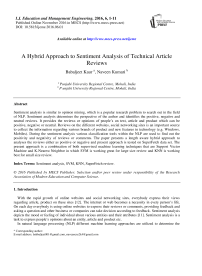A Hybrid Approach to Sentiment Analysis of Technical Article Reviews
Автор: Babaljeet Kaur, Naveen Kumari
Журнал: International Journal of Education and Management Engineering(IJEME) @ijeme
Статья в выпуске: 6 vol.6, 2016 года.
Бесплатный доступ
Sentiment analysis is similar to opinion mining, which is a popular research problem to search out in the field of NLP. Sentiment analysis determines the perspective of the author and identifies the positive, negative and neutral reviews. It provides the reviews or opinions of people's on text, article and product which can be positive, negative or neutral. Reviews on the different websites, social networking sites is an important source to collect the information regarding various brands of product and new features in technology (e.g. Windows, Mobiles). During the sentiment analysis various classification tools within the NLP are used to find out the positivity and negativity of reviews or comments. The paper presents a length aware hybrid approach to analyses the reviews either as positive or negative and present approach is tested on SuperFetch data set. The present approach is a combination of both supervised machine learning techniques that are Support Vector Machine and K-Nearest Neighbor in which SVM is working great for large size review and KNN is working best for small size review.
Sentiment analysis, SVM, KNN, SuperFetch review
Короткий адрес: https://sciup.org/15014036
IDR: 15014036
Список литературы A Hybrid Approach to Sentiment Analysis of Technical Article Reviews
- X. Fang, and J. Zhan, "Sentiment analysis using product review data," Journal of Big Data, pp.1-14, 2015.
- Y. Sharma, V. Mangat, and M. Kaur, "Sentiment analysis and Opinion mining," In Proceedings of 21st IRF International conference, March-8, 2015, Pune, India, pp. 35-38.
- A. Shoukry, and A. Rafea, "A Hybrid Approach for Sentiment Classification of Egyptian Dialect Tweets," In Proceedings of First International Conference on Arabic Computational Linguistics, 2015, pp. 78-85.
- S. Tan, and J. Zhang, "An empirical study of sentiment analysis for Chinese documents," Expert systems with applications 34 (2008), pp. 2622-2629.
- J. S. Guerrero, J. A. Olivas, F. P. Romero, and E. H. Viedma, "Sentiment analysis: A review and comparative analysis of web services," Information Sciences, pp. 18-38, 2015.
- U. Grandi, A. Loreggia, F. Rossi, and V. Saraswat, "A Borda count for collective sentiment analysis," Annals of Mathematics and Artificial Intelligence, 22 October 2015, DOI: 10.1007/s10472-015-9488-0.
- C. Li, B. Xu, G. Wu, S. He, G. Tian, and H. Hao, "Recursive Deep Learning for Sentiment Analysis over Social Data," In Proceedings of International Joint Conferences on Web Intelligence (WI) and Intelligent Agent Technologies (IAT), IEEE/WIC/ACM, 2014, pp. 180-185.
- A. Mudinas, D.Zhang, and M. Levene, "Combining Lexicon and Learning based Approaches for Concept-Level Sentiment Analysis," In Proceedings of the First International Workshop on Issues of Sentiment Discovery and Opinion Mining, ACM, August-12, 2012, pp. 1-8.
- E. Haddi, X. Liu, and Y. Shi, "The Role of text pre-processing in sentiment analysis," Information Technology and Quantitative Management, pp.26-32, 2013.
- Y. Sharma, V. Mangat, and M. Kaur, "A Practical Approach to Sentiment Analysis of Hindi Tweets," In Proceedings of 1st International Conference on Next Generation Computing Technologies (NGCT-2015), Dehradun, India, 4-5 September 2015, IEEE, DOI: 10.1109/NGCT.2015.7375207, pp. 677-680.
- J. S. Modha, G. S. Pandi, and S. J. Modha, "Automatic sentiment analysis for unstructured data," International journal of advanced research in computer science and software engineering, vol.3, pp.91-97, December -2013.
- A. Tripathi, A. Agrawal, and S. K. Rath, "Classification of Sentimental Reviews using Machine learning Techniques," InProceedings of 3rd International Conference on Recent Trends in Computing, ICRTC, 2015, pp. 821-829.
- B. Pang, and L. Lee, "Opinion mining and Sentiment analysis," Foundation and Trends in Information Retrieval, vol. 2, no. 1-2, pp. 1-135, 2008.


